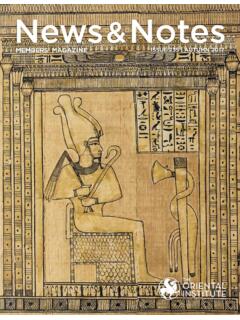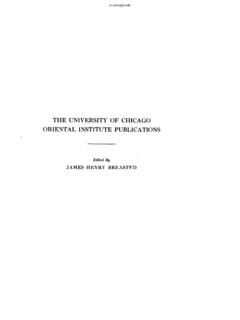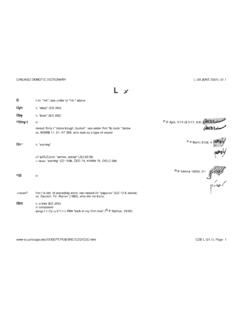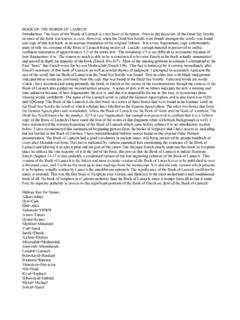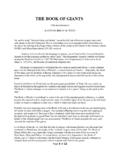Transcription of THE DEAD SEA SCROLLS AS TREATED IN A …
1 1 Norman Golb The University of Chicago 22 October 2007 THE DEAD SEA SCROLLS AS TREATED IN A RECENTLY PUBLISHED CATALOGUE Esthetically speaking, Dead Sea SCROLLS , the recently published San Diego exhibition catalogue, is a delight to behold: beautiful color photographs of twenty fragmentary texts, including some of the most historically interesting ones, accompanied by descriptions laudably designed to encourage the wider public s appreciative admiration. To make matters even better, the catalogue has been supplemented by similarly colorful photographs of pages from six ancient and valuable Bible codices in the collection of St. Petersburg s National Library of Russia, corresponding to the exhibit of those manuscripts simultaneously with the SCROLLS . Judging by the obvious care with which these photographs have been produced and presented, one may infer that a major concern of the exhibitors was to develop a lavishly produced volume serving to enhance the exhibit itself.
2 There can be little doubt that its purchasers will cherish what they have acquired.* General Plan of the Catalogue The cover of the volume contains a photograph of one of the so-called scroll jars, beneath which appears the title Dead Sea SCROLLS and, further down, the words San Diego Natural History Museum. On the title page indicating authorship, however, fuller information appears: First, boldly, Dead Sea SCROLLS followed by the words Presented by Joan and Irwin Jacobs, and then, in smaller print, From scroll to Codex: * The principal contributors to the catalogue are: as author, Dr. Rissa Levitt Kohn (cf. title page, bottom); as editor, Margaret Dykens; and as editorial board, H. Polkinhorn, M. L. Morreal, H. Shere, and D. Willett. Insofar as it is impossible to determine in certain cases precisely whose hand has been responsible for what, and although fully recognizing the author of the catalogue as the author, I am occasionally obliged to refer in the following pages to the above collectively as the editors.
3 There are also prefaces by Dr. Stephen L. Weber, President of San Diego State University, and Dr. Michael W. Hager, President and CEO of the San Diego Natural History Museum. The copyright page of the SD catalogue states at the bottom that the catalogue was developed in partnership with San Diego State University Press, made possible with a generous grant from President Stephen Weber's President's Leadership Fund. The next (and last) paragraph is to the effect that the exhibit is a joint production of the Israel Antiquities Authority, the Dead Sea SCROLLS Foundation and the San Diego Natural History Museum and is supported by an indemnity from the Federal Council on the Arts and the Humanities. In the following pages, all uses of italics in quoted passages are mine. A brief bibliography appears at the article s conclusion. 2 Ancient Bibles of the Near East. These statements indicate a somewhat different purpose than that usually associated with exhibitions of the Dead Sea SCROLLS , which in the past have as a rule been designed to highlight the scroll discoveries in and of themselves, without particular emphasis on the Biblical texts a policy developing naturally from the fact that approximately two-thirds of the SCROLLS are non-Biblical.
4 The unusual emphasis of the present exhibit is also shown by the list (p. 5) of the twenty manuscripts displayed or to be displayed, where eight are Biblical texts per se and another two are ancient commentaries on those texts. The addition to the exhibit of the six St. Petersburg Biblical codices, including two full Pentateuch manuscripts and a text of the Prophets containing 156 folios, results in a catalogue with twenty illustrated pages of these latter texts in addition to the twenty-eight pages given over to the Biblical SCROLLS and commentaries thereon, viz. the sum of 48 pages, out of a total of 79 pages given over to a presentation of the texts in the exhibit. In that sense the major emphasis of the exhibit as a whole is on the Bible rather than on the Dead Sea SCROLLS as representative of the thinking and culture of the Jews of Palestine during the intertestamental period in which they were mostly composed, and to which past scroll exhibits have, successfully or not, been devoted.
5 The conflicting claims of the catalogue s cover and title page appear to reflect an underlying ambiguity with respect to the exhibitors main purpose. The Biblical SCROLLS from the Caves We may now consider whether the catalogue presentation succeeds in either of its two ambiguously implied goals, turning first to its treatment of the Dead Sea SCROLLS Biblical fragments (pp. 12-30 and 50-53). The editors, as they indicate (p. 94), have in the first eight cases (pp. 12-30) based the English translations on a widely used 1985 Bible translation produced under Jewish auspices, with certain changes introduced by Dr. Martin Abegg Jr. to account for the variant readings found in the manuscripts. In the last two cases (pp. 50-53) the translations are based on the Revised Standard Version, a work produced under Christian auspices, with the variant readings introduced by Dr. Russell Fuller. Altogether, this part of the publishing project has been done in a most conscientious manner, with almost no typographical or other errors.
6 One observes, however, that each page of the catalogue preserves much white space, often 50% or more of it. The editors invite viewers (younger viewers, one may assume) to concentrate on these manuscripts with a continually repeated request, : Look at the scroll . Nowhere, however, do they guide those viewers toward understanding that the often obtusely translated Bible passages used in the catalogue represent only the translators particular interpretations of the ancient Hebrew texts. To cite but one example, in the catalogue s version of the Davidic poem in 2 Samuel 22, a typical verse (44) is translated in the past tense, as though describing a former historic event: You delivered me from strife with the peoples, you kept me as the head of nations. Other versions, however, more reasonably construe the passage as describing King David s present glory; see for example the Cambridge/Oxford Revised 3 English Bible, 1989, : You set me free from the people who challenge me, and make me master of nations.
7 Similar contrasts or contradictions could be demonstrated for virtually each of the English Bible translations presented in the catalogue (as for countless other passages of Biblical writings generally speaking) a fact of life that impacts on beginning students of ancient Hebrew literature soon enough. In the San Diego catalogue translations, where Biblical passages at times start or end in mid-sentence (cf. pp. 15, 17, 19, and 51), surely at least some of the white space could have been used to offer contrasting interpretations of at least some of the Biblical passages on display. This might have provided viewers, particularly those bidden to look, with an inkling of the challenges faced by translators of Biblical texts, and of the uncertainties blocking the way to a categorical interpretation of their contents. It is important to emphasize this feature of the catalogue as it now exists, particularly in view of the fact that, as we shall observe below, the descriptions accompanying each of the individual Biblical fragments seem to suffer from a similar characteristic.
8 Paleo-Leviticus (pp. 11-15): The script of the important palaeo-Hebrew Leviticus scroll is explained (p. 12) as being motivated by ancient scribes who, according to the catalogue s author, thought that palaeo-Hebrew was the original script both of the Torah (which was literally dictated by the God of Israel to Moses ), and of the Book of Job (of which palaeo-Hebrew fragments have likewise been found in Cave 11). This intensely spiritualizing view is hardly warranted by the nature of the evidence. Since palaeo-Hebrew was regularly used for ancient inscriptions and also is not confined to specifically Pentateuchal Dead Sea SCROLLS , its presence among the SCROLLS would appear simply to indicate a continuation diminished and unknown until those texts were discovered of literary use of this script among Jews of the Second Temple period, in the same way that other systems of writing, whether Semitic or not, have often survived for hundreds of years or more.
9 Deuteronomy scroll 1 (pp. 16-17): In introducing the first of two fragmentary texts of Deuteronomy, the author states that 32 copies of this book were discovered in the caves of the Judaean desert [,].. at Qumran, one at Masada, one at Murabba at and one at Hever or The italicized passage represents a disorienting conflation of diverse facts and concepts: a) The Hebrew manuscripts discovered at Masada, including the Deuteronomy text, were not found in caves. b) Manuscript discoveries in the Judaean Wilderness were indeed made at the sites listed in the catalogue. However, he catalogue puts them all in a single bundle, while it nowhere signals the different time-periods distinguishing the manuscripts found in Muraba at and Nahal Hever (of the Bar Kokhba period, circa 132-135 CE) from those found at Masada and in the eleven caves of the northern region of the wilderness (all prior to 70 CE). Without the chronological underpinnings, many readers are bound to become confused with respect to the actual meaning of 4 the phrase The Dead Sea SCROLLS , which has consistently been used, for good reason, to designate the discoveries of earlier date from those of the Bar Kokhba period.
10 C) Thirdly, Khirbet Qumran is the desert fortress site claimed by various authors to have been eventually inhabited by a Jewish sect whose members supposedly wrote, copied, and/or possessed Dead Sea SCROLLS there. The caves of the Judaean desert, on the other hand, originally designated those eleven caves in which the Dead Sea SCROLLS were discovered, stretching northward from the vicinity of Khirbet Qumran a distance of three kilometers to the area near where the Wadi Mukallik empties into the Dead Sea. The idea that this entire area could somehow be designated as Qumran is unknown prior to creation of the theory, circa 1949/1950, that the 11 caves housed manuscripts ostensibly hidden by the inhabitants of Kh. Qumran. As this belief gained almost universal acceptance in the 1950s, the claimed connection of the eleven manuscript caves with Kh. Qumran gradually resulted in the creation and subsequent popularity of the phrase at Qumran to imply an organic bond between the caves and Kh.


